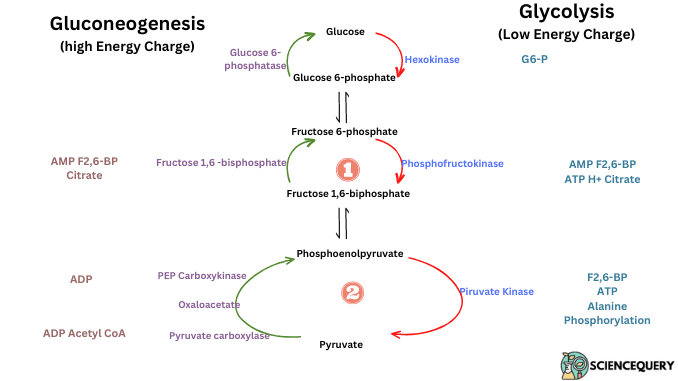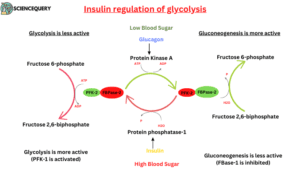
Know in one minute about the Regulation of Glycolysis
|
Introduction
Glycolysis is an oxidative process in which one mole of glucose is oxidized into pyruvate and produces energy in the form of ATP. And Regulation of glycolysis is the process by which the steady-state flow of glucose through a pathway is maintained.
Glycolysis (EMP pathway) is a universal pathway in living and it is the first stage of respiration. It is a sequenced reaction that converts glucose to pyruvate or lactate with the production of ATP.
Features of glycolysis
- Glycolysis takes place in all cells of the body.
- The enzymes which are involved in this pathway all are present in the cytosol fraction of the cell.
- Glycolysis occurs in the absence of oxygen which is called an anaerobic condition or in the presence of oxygen which is called an aerobic condition.
- Lactate is the end product under anaerobic conditions and in the aerobic condition, pyruvate is formed, which is then entered into the TCA cycle and oxidized to CO2 and H2O.
Importance of glycolysis
- Glycolysis is very essential for the brain which is dependent on glucose for energy. It is a major pathway for ATP synthesis in tissues lacking mitochondria.
- The intermediate of glycolysis is useful for the synthesis of amino acids and fat.
What is the regulation of glycolysis?
The flow of glucose in the body is maintained by the regulation of glycolysis. It helps in starting and stopping the glycolysis process depending upon the ATP requirement of the body. Thus it is the process by which the steady-state flow of glucose through a pathway is maintained.
Regulation of glycolysis inside the cell occurs in two types.
- When ATP concentration is high, the body doesn’t want more energy, in such conditions glycolysis becomes inhibited and negative regulation is found.
- And when ATP concentration is low, AMP and ADP are present in increased amounts, this time positive regulation is found.
Factors that regulate glycolysis
The three main key enzymes that regulate glycolysis are phosphofructokinase, hexokinase, pyruvate kinase, and AMP, and low pH are regulators of these enzymes, acetyl CoA and oxygen also regulate glycolysis.
1. Regulation by hexokinase
Hexokinase is inhibited by glucose 6-phosphate. This enzyme prevents the accumulation of glucose 6-phosphate due to product inhibition.
2. Regulation of metabolism by PFK
Phosphofructokinase (PFK) is an important regulatory enzyme in glycolysis. It is an allosteric enzyme regulated by allosteric effectors ATP, citrate, and H+ ions are the most important allosteric inhibitors, and fructose 2,6-bisphosphate, ADP, and AMP are the allosteric activators. A high concentration of ATP leads to a high energy charge value, ATP binds to the active site of PFK1, thereby enzyme affinity for the substrate fructose 6-phosphate.
3. Role of fructose 2,6-bisphosphate(F2,6BP)
Fructose 2,6-bisphosphate is an important regulatory factor for controlling PFK. Fructose 2,6-bisphosphate is formed from fructose 6-phosphate by the enzyme phosphofructokinase called PFK2.
The activity of PFK2 and fructose 2,6-bisphosphate is controlled by a covalent modification which is regulated by cyclic AMP. Cyclic AMP is the second messenger for certain hormones.
Cyclic AMP dephosphorylated the bifunctional enzyme, thus the active site of the enzyme is inactivated which is responsible for the fructose 2,6-bisphosphate but activation of the active site is responsible for the hydrolysis of fructose 2,6-bis-bisphosphate.
4. Regulation by Pyruvate Kinase
Pyruvate kinase is allosterically inhibited by high levels of ATP. Pyruvate is also used to build amino acids; high levels of alanine amino acid inhibit its activity.
When ATP demand increases, fructose 1,6-bisphosphate acts as a positive allosteric effector and stimulates pyruvate kinase activity.
5. Regulation of glycolysis and gluconeogenesis
Glycolysis and gluconeogenesis are reciprocally regulated. gluconeogenesis is the formation of glucose from non-carbohydrate sources.
In animals, this takes place in the liver and to a minor extent in the kidney cortex. Its Major purpose is to keep up a sufficient glucose supply to the brain and muscles.
Most reaction steps are a reversal of the respective glycolysis reactions, with the exception of those reactions which are highly regulated in glycolysis and thus usually far from equilibrium, they are replaced by alternative reactions, which are energetically more favorable in the direction of glucose synthesis (glucose 6-phosphatase instead of glucokinase/hexokinase, hexose diphosphatase instead of phosphofructokinase).
When the ATP level low is related to AMP, this will give a signal to produce more ATP and stop using ATP to produce glucose via gluconeogenesis.
In there, gluconeogenesis is inhibited and glycolysis is activated. These enzymes are involved in gluconeogenesis:-
PFK- it is activated by AMP and fructose-2,6 bisphosphate
Pyruvate kinase- it is activated by fructose-1,6 bisphosphate
Fructose-1,6 phosphatase- It is inhibited by AMP and fructose-2,6 bisphosphate
PEP carboxykinase and Pyruvate Carboxylase- both are inhibited by ADP.
These enzymes are also inhibited by AMP and activated by citrate Further, the expression of enzymes is regulated by hormones. These are:-
- Catecholamines (Repress (via cAMP)
- Catecholamines (Induce (via cAMP)
- Glucocorticoids
- Glucagon induces (via cAMP)
Reciprocal regulation of glycolysis and gluconeogenesis

- Our liver cells and to a much lesser extent our kidney cells are responsible for regulating and maintaining our blood glucose level.
- These cells must regulate glycolysis and Gluconeogenesis in a reciprocal manner to ensure that proper glucose levels are maintained.
- Glycolysis and Gluconeogenesis, the two pathways are under Reciprocal allosteric control, mainly achieved by the opposite effects of fructose 2,6-Bisphosphate on PFK-2 and FBPase-2.
- Reciprocal manner means if one pathway is activated then another pathway is inhibited.
- These two enzymes worked in two states:-
- Unphosphorylated form: The PFK2 enzyme is activated and FBPase-2 is inhibited. PFK-2 is responsible for converting fructose 6 Phosphate into fructose 2,6 bisphosphate.
- Phosphorylated form: The PFK2 enzyme is inactivated and FBPase-2 is activated. FBPase-2 is responsible for converting fructose 2, 6 bisphosphates into fructose 6, phosphate by phosphorylation.
Allosteric regulation of glycolysis
- The glycolysis pathway is highly regulated by the allosteric modulation of several glycolytic enzymes. Only three key glycolytic enzymes are under the control of allosteric modulators. They are Hexokinase, phosphofructokinase (PFK), and pyruvate kinase.
- If ATP concentration is high, we don’t need glycolytic flux, we need the flux deviated towards other pathways such as the pentose phosphate pathway, glycogenesis.
- In such conditions where ATP concentration is high and the body wants to stop the reaction. Hence, it stops by modulating pyruvate kinase and phosphofructokinase activity so ATP concentration works like an allosteric modulator.
- Thus, increasing ATP concentration prevents PFK and pyruvate kinase. On the other hand, ATP concentration is low, the body needs energy in such kind of situation ATP concentration works as an allosteric activator.
Insulin regulation of glycolysis

- The blood glucose level rises to the normal value, this causes the beta cells of the pancreas to produce and release a hormone called insulin.
- Regulatory processes are triggered from Outside the cell by the hormones insulin and glucagon, which signal too much or too little glucose in the blood.
- These Hormonal signals bring about covalent modification (phosphorylation or dephosphorylation) of target proteins inside the cell.
- When the blood glucose level decreases, the hormone Glucagon signals the liver to produce and release more glucose and to stop consuming it for its own needs.
- One Source of glucose is glycogen stored in the liver; another Source is gluconeogenesis.
- The hormonal regulation of glycolysis and gluconeogenesis is mediated by fructose 2,6-bisphosphate, An allosteric effector for the enzymes PFK-1 and FBPase-1.
- Glucagon or epinephrine decreases (fructose 2,6-bisphosphate). The hormones do this by Raising [cAMP] and bringing about the Phosphorylation of the bifunctional enzyme that makes and breaks down fructose 2,6-Bisphosphate.
- Phosphorylation inactivates PFK-2 and activates FBPase-2, leading to the breakdown of fructose 2,6-bisphosphate. Insulin Increases [fructose 2,6-bisphosphate] by Activating a phosphoprotein phosphatase that Dephosphorylates (activates) PFK-2.
Reciprocal regulation of glycolysis and gluconeogenesis
- Our liver cells and to a much lesser extent our kidney cells are responsible for regulating and maintaining our blood glucose level.
- These cells must regulate glycolysis and Gluconeogenesis in a reciprocal manner to ensure that proper glucose levels are maintained.
- Glycolysis and Gluconeogenesis, the two pathways are under Reciprocal allosteric control, mainly achieved by the opposite effects of fructose 2,6-Bisphosphate on PFK-2 and FBPase-2.
- Reciprocal manner means if one pathway is activated then another pathway is inhibited.
- These two enzymes worked in two states:-
1. In the unphosphorylated form, the PFK2 enzyme is activated and FBPase-2 is inhibited. PFK-2 is responsible for converting fructose 6 Phosphate into fructose 2,6 bisphosphate.
2. In the phosphorylated, the PFK2 enzyme is inactivated and FBPase-2 is activated. FBPase-2 is responsible for converting fructose 2, 6 bisphosphates into fructose 6, phosphate by phosphorylation.
Q&A
Why is regulation of glycolysis important?
To maintain the glucose level in cells, regulation of glycolysis is very important.
What form of regulation do you think the cell would have on genes involved in glycolysis?
Genes involved in reciprocal regulation or insulin regulation of glycolysis. Insulin affects the rate of gene expression.
Given what you know about glycolysis and the regulation of metabolism?
Glycolysis is the metabolic pathway where glucose oxidizes into pyruvate to generate energy and maintains the steady-state concentration of the intermediates in a pathway called regulation of metabolism.
References
Biochemical Pathways: An Atlas of Biochemistry and molecular biology.
4th edition biochemistry Donald Voet & Judith G. Voet
Lehninger, 4th edition, Principal of biochemistry, David L. Nelson & Michael.
Biochemistry, 4th edition, U. Satyanarayana, U. Chakrapani.
Written By: Richa Pachori
